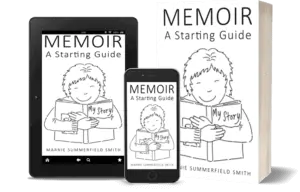
Some authors start at the beginning with what they know of their birth. Others with what they know of their ancestors. Many people open with a life-changing, amusing or shocking moment to draw their readers in.
Much of this decision depends on whether your memoir is private or public, and your intended audience.
Either way, I encourage people to start any-old-where, and to write without stopping, then go back to edit and rewrite. But I know that plenty of people ignore this advice and go over and over the opening of their books, aiming for perfection, and sometimes paralysing their creativity and denting their confidence in the process.
A good opening will likely come towards the end of the process, when you have a new or enriched perspective.
And where to end our memoirs?
If you’re writing a legacy memoir of family stories and your own, and you’ve reached a ripe old age, some thoughts as you look back on life can work well. Some wisdom for the generations to come. Some gratitude. Or some kvetching if that’s your bag.
If you’re writing a story from your life, which can be the definition of memoir, rather than the whole shebang, cradle-to-grave, which is what some people call autobiography, then you need a neat ending. But life doesn’t usually give us neat endings, so I encourage my authors to think of their story as having not a beginning, a middle and an end, but a beginning, a middle and a new beginning.
Finish with new insight, a new perspective or just the fact that you’ve survived.
Many authors come to me having written or with ideas of introductions, forewords, prologues and epilogues. These can work brilliantly in some circumstances. But I encourage you to avoid them. The reason is that people usually write them at a stage in their process (a stage you have to go through) when they don’t have confidence that they’re going to be able to fully and clearly express themselves. So, they write these garnishes by way of explanation. Asking their readers: Do you know what I mean? This is what I went through, sort of thing.
This style of writing can come from the old adage: tell people what you’re going to tell them, tell them, then tell them what you’ve told them. That’s for public speaking in the main. No good for memoir. You need to trust the reader and give them space to draw their own conclusions. Yes, give them all the information and emotions, but weave it into your story. Let them find out stuff at the same time you – our main character and narrator – does.
You may be used to academic writing and feel the urge to sum up. Don’t. Finish your story with us, the reader, taking a final glimpse into your world. You want to give your readers an experience, not a lecture.
Write your intro, foreword, prologue and epilogue if you like, but only to help you formulate your thoughts. Make them part of those early drafts where you are telling yourself the story. Your confidence will grow with every draft, I promise. And when you’re ready, you can turn your story to face the world.
And when you do, you might imagine it as a beautiful hot air balloon. And that’s when it’s time to snip off the extraneous bits, release the ropes that have it tethered to the ground, and let it fly.
